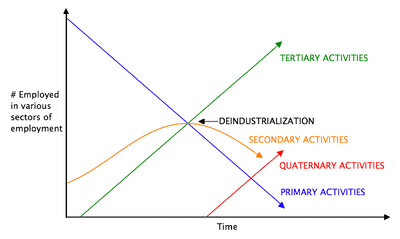Results 1 to 1 of 1
Thread: Peak Employment
Thread Information
Users Browsing this Thread
There are currently 1 users browsing this thread. (0 members and 1 guests)
-
07-11-2012, 12:28 AM #1Senior Member


- Join Date
- May 2007
- Location
- South West Florida (Behind friendly lines but still in Occupied Territory)
- Posts
- 117,696
Peak Employment
Guest Post: Peak Employment

Submitted by Tyler Durden on 07/10/2012 15:33 -040
Submitted by GoJam of The Needle Blog,Peak Employment
What is ‘Peak Employment’ ?
Peak employment is the theory that due to factors such as efficiency, driven by technological innovation, and demand, developed economies may have already passed beyond the highest point of employment and that from this point onwards employment will continue to fall and unemployment inexorably rise causing increased social tension. There is plenty of evidence to support this theory but before looking at the situation now it would be wise to look first at a similar period of dramatic technological change two hundred years ago, and try and understand why the Luddites, who opposed industrial progess were wrong and take it as a small warning against making similar mistakes.
It is almost exactly two hundred years since the Luddites were founded (1811) as a reaction to the Industrial Revolution sweeping Great Britain. Today they are thought of simply as technophobes but their concerns were genuine, even if their methods were shortsighted and ultimately futile. The Luddites were originally highly skilled, and relatively high paid, textile workers who were being supplanted by low skill and low wage labour who were needed to operate the new mechanized looms. Their solution was to smash up the looms.
The Industrial Revolution initiated profound social change in Great Britain. There was a huge migration from the countryside to the new industrial centres, creating a surplus of labour and driving wages downwards in these growing cities, and the new technology, being more efficient needed far less labour to produce far greater product.
The Luddites certainly saw that their standard of living was threatened but they might have been forgiven if they thought they foresaw ‘Peak Employment’. Afterall, if fewer workers were needed to produce the same quantity of product unemployment must inevitably rise, right?
They were, as we all know, wrong. There were two main reasons why, the first was that Great Britain had a huge captive market in it’s growing empire, the second was that the Industrial revolution needed huge ‘support’ industries, like mining and steel production, and spawned newer technologies which created new markets and drove important infrastructure development, like the railways and shipping.
But if the Industrial Revolution did not precipitate ‘Peak Employment’ could it be said to have stoked social unrest?
“The concept of “Skill Biased Technological Change” (SBTC) posits that technology contributes to the de-skilling of routine, manual tasks.A changing world and new technologies are usually to blame for the world’s worries.”
Was the invention of the printing press responsible for the Reformation and the religious unrest that followed ? Was the invention of the combustion engine, mechanisation, and the production line responsible for the early 20th century conflicts ? Or did atomic power shape the late 20th century conflicts ? These questions I’ll leave to you, as I think I’m already wandering away from the subject of this article, which is ‘Peak Employment’.
So, it’s time to now look at the most recent technological innovations which are shaping our world today, the internet and computerisation. I’m going to look at the UK but I’m sure the findings can be extrapolated for all developed western economies.
Clark’s Sector Model (1950)

Industry, and thus employment, can be divided in to 5 broad sectors.
As you can see Clark’s Sector Model has been shown to be broadly correct in the 60 years since it was developed. Primary and Secondary sectors have decreased, Tertiary and Quaternary sectors have increased, the sub- branch, Quinary sector which Clark’s Sector Model does not address has also increased.
“Primary: This involves the extraction of resources directly from the Earth, this includes farming, mining and logging. They do not process the products at all. They send it off to factories to make a profit.
Secondary: This group is involved in the processing products from primary industries. This includes all factories—those that refine metals, produce furniture, or pack farm products such as meat.
Tertiary: This group is involved in the provision of services. They include teachers, managers and other service providers.
Quaternary: This group is involved in the research of science and technology. They include scientists.
Quinary: Some consider there to be a branch of the quaternary sector called the quinary sector, which includes the highest levels of decision making in a society or economy. This sector would include the top executives or officials in such fields as government, science, universities, nonprofit, healthcare, culture, and the media.”
There is an alternative way of looking at sectors of employment and that is to look at those that are used to evaluate GDP.
They are:
- Agriculture, hunting, forestry, and fishing
- Construction
- Production industries, Electricity, gas and water supply, Manufacturing, Mining and quarrying.
- Service industries, Creative industries, Education, health and social work, Financial and business services, Hotels and restaurants, Other social and personal services, Public administration and defence, Real estate and renting activities, Tourism, Transport, storage and communication, Wholesale and retail trade.
The first employment sector has become more efficient due to mechanisation but, for now, it is now kept relatively stable thanks to EU subsidy.
The second employment sector is slumping but has potential for growth but you only have to look at Spain and Ireland to see examples of how an artificially stimulated construction sector can result in a bubble.
The third employment sector is more complicated. The utlities are private monopolies, infrastructure improvements could create employment but it’s difficult to see this happening without state intervention of some sort. Manufacturing has been moving east and shows no sign of returning any time soon. Mining has reduced significantly over the last 30 years, Quarrying remains controversial and is resisted locally.
The fourth employment sector, the service sector, is by far the largest making up 73% of UK GDP and it is perhaps hit the hardest by new technologies, specifically Retail and Financial business services where jobs are being regularly shed. And what is left in that sector?
A large bulk of it is the Public Sector, most of the rest is take-aways, cinemas, and theme parks. OK, that is a simplification but these sectors, excepting overseas tourist related, just circulate money around the economy. And that is the only employment sector which remains relatively high, for now, but it is plainly unsustainable.
Employment is falling, unemployment is rising but hidden behind those headlines is the fact that part time Employment is rising.
Less people have full time jobs, more people have part time jobs, which means that the hours of work are being spread increasingly more thinly across the population.
Some might argue that it is only because of the economic slump that all of these things are happening and that it is only temporary.
But I think there is enough evidence to suggest that this is a long term trend that has just been disguised by the boom of the last ten years and is only now really becoming apparent.
I fear that we have already passed Peak Employment and the downward trend will continue, perhaps disguised by increasingly more part time employment.
Guest Post: Peak Employment | ZeroHedgeJoin our efforts to Secure America's Borders and End Illegal Immigration by Joining ALIPAC's E-Mail Alerts network (CLICK HERE)


 LinkBack URL
LinkBack URL About LinkBacks
About LinkBacks




 Reply With Quote
Reply With Quote


Rep. Grothman: DHS monitoring over 600,000 illegals with...
04-23-2024, 07:07 PM in General Discussion